#Halime Sultan
Explore tagged Tumblr posts
Text
Simillarities between consorts Pt. 3

Gülçiçek Hatun & Hüma Hatun
Both were concubines of a sultan named Murad (Gülçiçek of Murad I, Hüma of Murad II).
Both have been confused in historical sources with the sultan’s royal wives (Gülçiçek with Tamara Hatun, Hüma with Mara Hatun).
Both were possibly of Greek origin.
Both became mothers of future sultans

Olivera Lazarevic & Mara Brankovic
Both were Serbian princesses, and were even related to each other.
Both were known as Despina Hatun.
Olivera was loved by the Serbs but disliked by the Ottomans. Mara was respected by the Ottomans, but her dynasty wasn’t celebrated by Serbs, especially because of stories that Mara’s grandfather had betrayed Prince Lazar (Olivera’s father).
Both experienced tragic events during their marriages, Olivera was captured together with Bayezid I, while Mara’s husband had her brothers captured and blinded.

Safiye Sultan & Halime Sultan
Both had the son named Mahmud.
Both were disliked by their mothers-in-law, Safiye by Nurbanu Sultan, and Halime by Safiye Sultan.
Both were exiled because of letters involving a kind of witchcraft, and in both cases, the letters ended up in the hands of their mother-in-law.
Both faced rebellions ,directly or indirectly that were aimed against them.
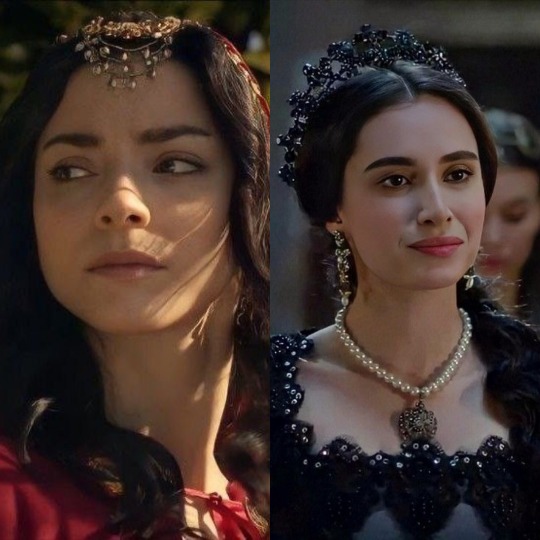
Nurbanu Sultan & Kösem Sultan
Both entered the imperial harem at the age of 12.
They lived a century apart, Nurbanu passed away in 1583, while Turhan in 1683.
Foreign ambassadors mistook both for being of Circassian origin in their reports.
their grandsons ascended the throne exactly 100 years apart, Mehmed III in 1595 and Mustafa II in 1695.
Both women were known for their beauty, generosity, and the affection they inspired among the people.
#ottoman empire#youtube#hatun#history#fyp#istanbul#hasekisultan#sultan#sultanmurad#consorts#turhan sultan#halime sultan#safiye sultan#nurbanu sultan#princess#serbianprincess#marabrankovic#marahatun#oliverahatun#olivera lazarevic#hüma hatun#fatihsultanmehmed#sultan murad#similarities#similar#serbiankingdom#serbia
5 notes
·
View notes
Text














"The Valide Sultan’s seat of authority was often placed near the window or in a prominent corner of her chamber, where light illuminated her figure, further emphasizing her elevated status as the mother of the Sultan and the head of the imperial household." - Ottoman Women in Public Space, Madeline C. Zilfi
#Muhteşem Yüzyıl#Magnificent Century#mcedit#Muhtesem Yuzyil#kosemedit#Muhtesem Yuzyil kosem#magnificent century kosem#Muhteşem Yüzyıl Kösem#Hurrem Sultan#Kosem Sultan#history#historyedit#Ottoman history#Asian history#Turkish history#Sultanate of Women#weloveperioddrama#perioddramaedit#period drama#historical drama#Magnificent Century: Kösem#mc: kosem#Awkward-Sultana#Handan Sultan#Halime Sultan#Safiye Sultan#Hafsa Sultan
263 notes
·
View notes
Text
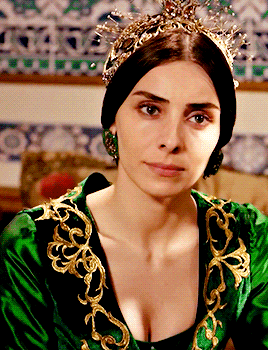
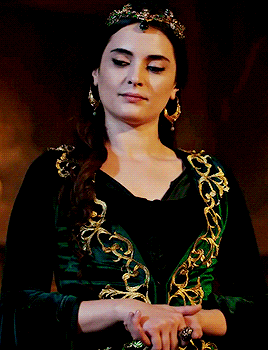
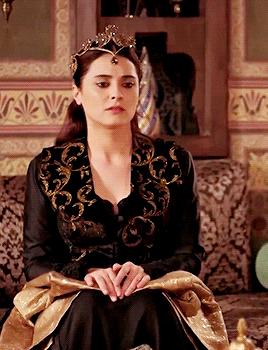
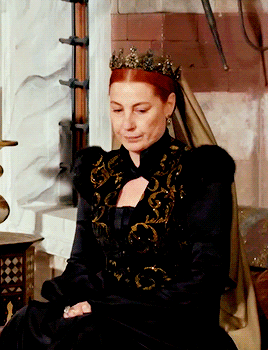

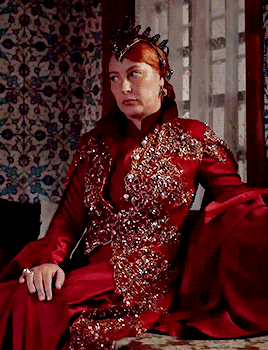

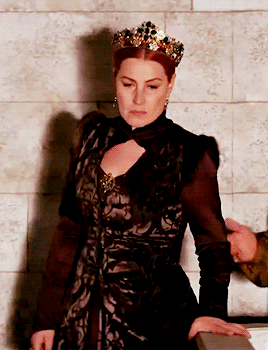
Halime Sultan wearing Hurrem Sultan's and Mahidevran Sultan's clothes - asked by anon
#magnificent century#magnificent century kosem#muhteşem yüzyıl kösem#muhtesem yuzyil#perioddramaedit#onlyperioddramas#weloveperioddrama#periodedit#hurrem sultan#halime sultan#mahidevran sultan#mine
242 notes
·
View notes
Text


ASLIHAN GÜRBÜZ AS HALIME SULTAN
the most beautiful people we have known are those who have known defeat
#halime sultan#aslihan gürbüz#aslihan gurbuz#magnificent century: kosem#muhteşem yüzyıl: kösem#muhtesem yuzil kosem#magnificent century#mcedit#perioddramaedit#period drama
39 notes
·
View notes
Text




Costumes
From: Magnificent Century: Kösem, ep. 30 Character: Halime Sultan Actor: Aslıhan Gürbüz Costume By: Serdar Başbuğ
(requested by anonymous)
#magnificent century: kosem#muhtesem yuzil kosem#kosemedit#perioddramaedit#costumeedit#halime sultan#Aslıhan Gürbüz#S1E30 Breath of the World#mcks1#costume sets#costume edits#requests#my edits
44 notes
·
View notes
Text




HALIME SULTAN APPRECIATION 6 / ∞
#perioddramaedit#magnificent century: kosem#aslıhan gürbüz#halime sultan#muhtesem yuzil kosem#muhteşem yüzyıl: kösem#queen shit
29 notes
·
View notes
Text






Sultans and Their Colorful Clothes + Halime Sultan's dark green caftan and yellow patterns
#halime sultan#aslıhan gürbüz#muhteşem yüzyıl kösem#muhtesem yuzil kosem#magnificent century kösem#magnificent century kosem#mc: kosem#kosemedit#costume#fashion#dress#perioddramaedit#periodedit#period rp#ottoman#period drama#periodedits#osmanlı#period#perioddramasource#perioddramagif#historical drama#history#queensofbeauty#dailywomanedit#dailyactresses#dailywomen#femaledaily
62 notes
·
View notes
Text
In defense of my girls Halime and Dilruba
I recently wrote posts about Turhan and Safiye, and thought why not make a series about Kosem's villains?
Today we're talking about my girls Halime and Dilruba, two characters that are both heavily villainized by the fandom and framed as in the wrong in the show, despite their motivations being really understandable, and their actions not much different from the ones of beloved character.
Halime
Halime is often accused of being responsible for Mustafa's suffering, because she kept trying to enthrone him. For me, this lowkey comes from the same place as people who say Hurrem could have just ended the fratricide law if she just let Mustafa (from MC) ascend because Mustafa is kind and would never kill his siblings. Let's be objective here, the Ottoman dynasty had been practicing fratricide for generations, what mother of a prince would believe it is completely finished and her son is safe just because the new sultan just said so? Her son would essentially be living with a damocles sword over his head for his entire life, that's not acceptable for a mother. And indeed, we see that it took two other generations of sultans for fratricide to truly end (Osman II killed Mehmet, Murad IV killed all his living brothers except one).
Also in the beginning of the show Halime was reeling from terrible trauma. Her eldest son Mahmud had been executed a few months ago for very flimsy reasons. He was only 16 and made one fatal mistake, asking his father to let him lead the army against the jelali bandit. On top of that, it was found out that Halime was consulting fortune tellers to see if Mahmud would ascend and that played a part in the decision to execute him, which means she would be crushed by guilt.
Also it's worth pointing out that when Ahmet made the decision to spare his brother, he was only 13 and had no heir, Halime had every reason to believe that once he had a son, Mustafa would be killed (and Safiye indeed says as much), which explains why she tried to prevent Mahfiruze from giving birth. And on top of that, Handan was working behind the scenes to get rid of Mustafa so even if Ahmet truly wanted to spare Mustafa, his closed one did not want too (just like Mustafa/Mahidevran in MC)
On top of that Ahmet often went back in forth in his decision to spare Mustafa. Even on episode 1, after escaping from a trap once, he was already deciding the best thing was to get rid of the toddler, how can Halime trust him?
As for her attempts to kill Ahmet's children, it's bad but it's no different than what other mother of princes had done and honestly if Halime had been smarter and gotten rid of all Ahmet's children (except maybe Bayezid since he does not have an influential mother to guarantee succession), she would have prevailed.
Dilruba
A lot of the arguments are the same as for her mother. She was a little girl who went to extreme trauma as her own father killed her brother, and then her little brother's life was constantly under threat.
Some people hate on her for revealing Handan's secret love for Dervish but honestly, I like Handan but why would Dilruba care about the woman who tried to kill her brother? Also Kosem calling her this little girl evil when she's the one who forced Handan to denounce Dervish, leading to his death and Handan's depression, is just next level hypocrisy.
Her decision to bring back Mustafa when the coup was happening also makes perfect sense. Safiye is terrible but at least with her, her brother would be sultan and "safe", whereas if she stays with Kosem, she's taking the party of Ahmet, whose an active threat on her brother's life, and even more now that the coup has been set in motion.
Also she was cruel as an adult but she was right in her reasoning and had good motives, again if they had gotten rid of these children, they would be rid of Kosem and there would be no threats to Mustafa's reign. And some might say but the army might depose him anyway but I find that truly unrealistic, the end of the Osman dynasty pretty much means the end of the Empire (there's a reason why its the same dynasty from start to finish) so even a weak, crazy sultan will be preferred. Case in point : Ibrahim was enthroned despite being mentally weak and everyone was anxiously waiting for him to reproduce, they were not looking to take advantage of his weakness to establish a new dynast
Her killing Osman's baby was terrible but also no different than Suleiman ordering Mustafa's son death or Selim ordering the death of Bayezid's children. This baby for being a male was a threat to her brother and it's also a fact that Osman had already killed his brother and announced his decision to make his son his heir, so how long before he went after the other male members of the dynasty ?
In short, these two women are no saints but they are way too villainized even though their motivations are the same as beloved character like Hurrem, and they both had traumatic experiences that shaped who they became.
14 notes
·
View notes
Text


bitter that we didn't see selim and nurbanu's wedding
#i was personally robbed by this. also i miss them very much#nurbanu sultan#selim ii#selim x nurbanu#halime sultan#kösem sultan#muhteşem yüzyıl#muhtesem yuzyil#muhtesem yuzil kosem#magnificent century#mc tag
45 notes
·
View notes
Text
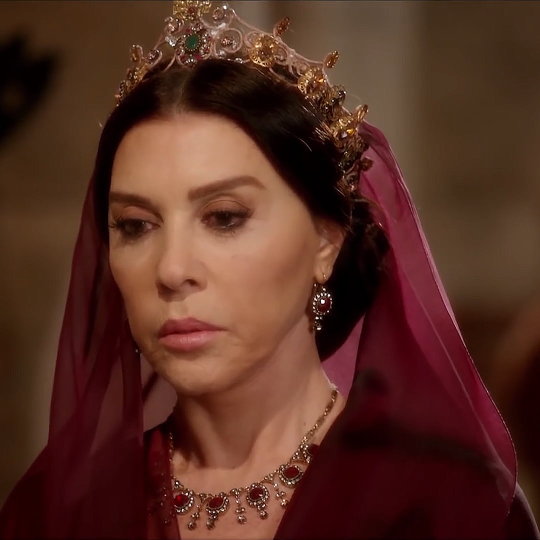
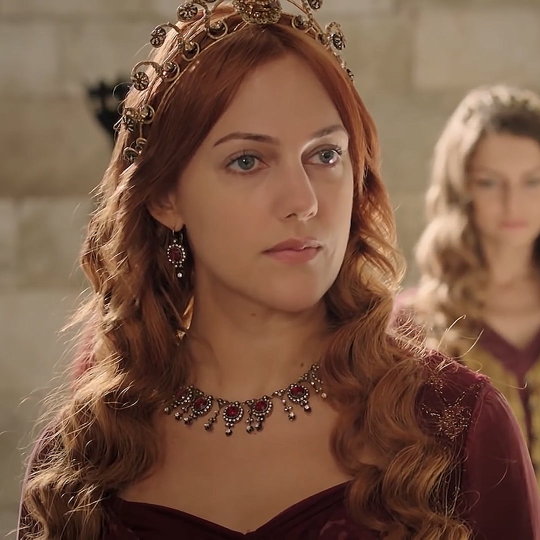
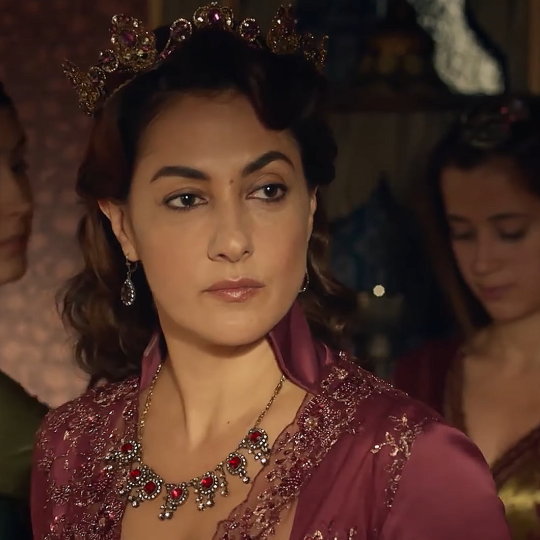

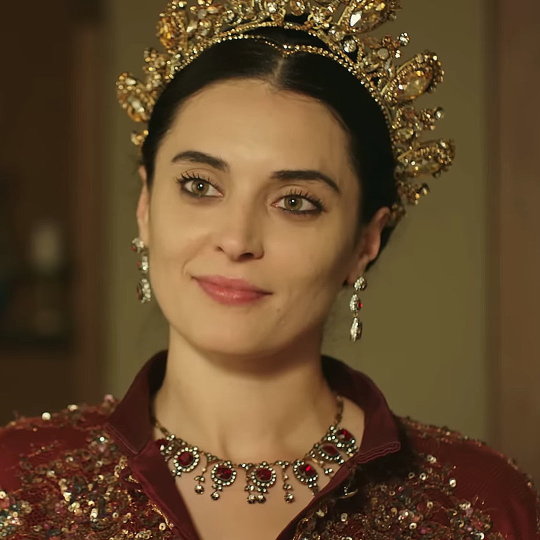
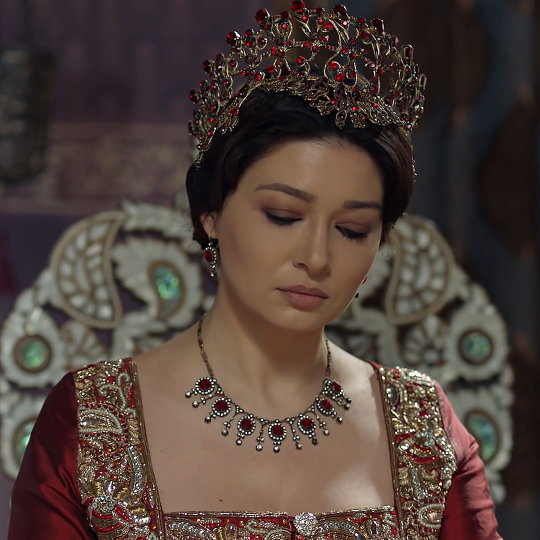
This silver necklace with red stones was first worn by Hafsa Sultan in the nineteenth epiosde of the second season of Magnificent Century. It is next seen on Hürrem Sultan in the third episode of the third season. The necklace is worn twice in fourth season, first by Fatma Sultan in the third episode and then by Mihrimah Sultan in the thirty-first episode.
The necklace makes another appearance on Halime Sultan in the twenty-sixth episode of the first season of Magnificent Century: Kösem. Finally, the necklace is worn by Kösem Sultan in the fifth episode of the second season.
#Muhteşem Yüzyıl#Muhteşem Yüzyıl: Kösem#Magnificent Century#Magnificent Century Kösem#Magnificent Century Kosem#period drama#costume drama#historical drama#Hafsa Sultan#Hürrem Sultan#Hurrem Sultan#Fatma Sultan#Fatma Sultan (Daughter of Hafsa)#Mihrimah Sultan#Mihrimah Sultan (Daughter of Hürrem)#Halime Sultan#Kösem Sultan#Kosem Sultan#reused jewellery#recycled jewellery
34 notes
·
View notes
Text


My two favourite sapphics in Magnificent Century Kosem . History will say they are just best friends
#magnificent century#magnificent century kosem#halime sultan#menekse#Menekşe hatun#kosem sultan#studio ghibli#ghibli aesthetic#witchcore#witchy vibes#queer#queer vibes#sapphic#saphhic vibes#lesbians#historical lesbians
7 notes
·
View notes
Text
Simillarities between consorts Pt. 2:
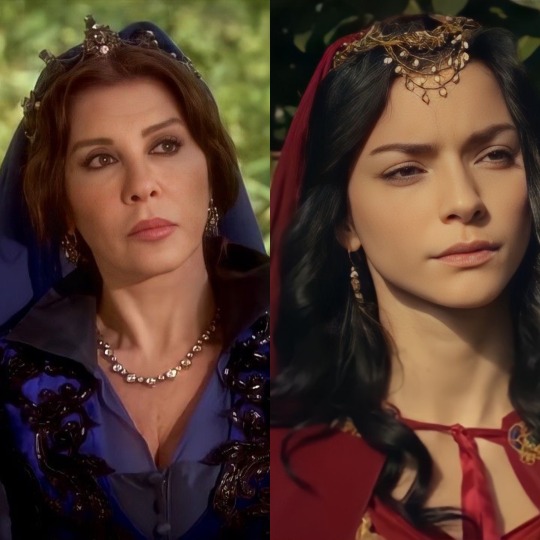
Ayşe Hafsa Sultan & Nurbanu Sultan
Both were consorts to sultans named Selim.
Both gave birth first to daughters.
Ayşe Hafsa was the first to hold the title of Valide Sultan, while Nurbanu was the first to hold it as an official, legally recognized position.
Both were known for their beauty.
Both were charitable and beloved by the people.

Handan Sultan & Saliha Dilaşub Sultan
Both were of Balkan Slavic origin (Handan was Bosnian, Dilaşub may have been Serbian ).
Both were the first concubines presented to the prince/sultan.
Both served only 2 years as Valide Sultan.
Both were favored by their mothers-in-law.
Both had sons named Süleyman (Handan’s son died in childhood)
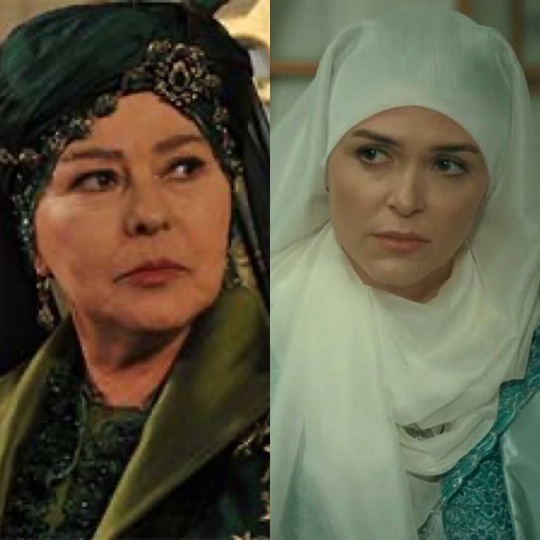
Servetseza Kadın & Rahime Perestu Kadın
Both were of Circassian origin.
Both were consorts of Sultan Abdülmecid I.
Both adopted children of other consorts who had passed away.
The sons they adopted later became sultans.
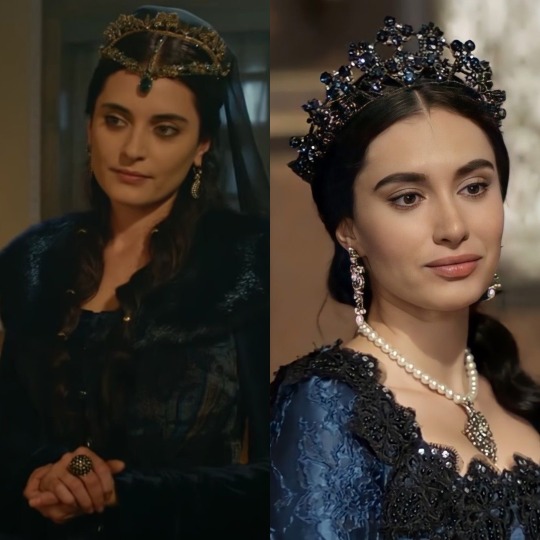
Turhan Sultan & Halime Sultan
Both fell out of Sultan's favor
Both had rivalries with their mothers-in-law.
Both served as regents during their sons’ reigns.
#ottoman empire#history#hatun#youtube#fyp#hasekisultan#istanbul#sultanmurad#sultan#consorts#turhan sultan#halime sultan#ayse hafsa sultan#nurbanu sultan#circassians#venetian#handan sultan#sultan süleyman#sultanabdulhamid#sultan ibrahim#sultanahmet#fypシ#turkish history#tumblr#similarities
9 notes
·
View notes
Text


























"Throughout history, hairdressing has been an intimate, almost ritualistic activity shared between women, whether in African braiding traditions, European court styles, or among women preparing for celebrations. The act of doing another woman’s hair binds them in a unique, nonverbal closeness." - Femininity, Susan Brownmiller (1984)
#Muhteşem Yüzyıl#Magnificent Century#mcedit#Muhtesem Yuzyil#Hurrem Sultan#kosemedit#Muhtesem Yuzyil kosem#magnificent century kosem#Muhteşem Yüzyıl Kösem#weloveperioddrama#perioddramaedit#historyedit#period drama#historical drama#New Home New Rules#The Forced Exile#The Rising Sun#The Realm of Legend#Mihrimah Sultan#Firuze Hatun#Mahidevran Sultan#Fidan Hatun#Gulsah Hatun#Halime Sultan#Dilruba Sultan#Ayse Sultan#Hanzade Sultan#Humasah Sultan#Nilufer Hatun#Fahriye Sultan
75 notes
·
View notes
Text








Halime Sultan's dark blue gown and blue goldish lace kaftan in episode 30 -asked by anon
#magnificent century#magnificent century kosem#muhtesem yuzyil kosem#muhtesem yuzil kosem#muhtesem yuzyil#wspaniałe stulecie#weloveperioddrama#periodramaedit#onlyperioddramas#periodedit#halime sultan#aslihan gurbuz#*halime sultan
69 notes
·
View notes
Text




ASLIHAN GÜRBÜZ AS HALIME SULTAN
you caused a mother the experience of losing a child you're a mother too, kosëm, you can feel it in your heart
#halime sultan#aslihan gürbüz#aslihan gurbuz#magnificent century: kosem#muhteşem yüzyıl: kösem#muhtesem yuzil kosem#magnificent century#mcedit#perioddramaedit#period drama
43 notes
·
View notes
Note
Hello,I read somewhere that there is version in Secrets of the Ottoman court,private lives of the Ottoman sultans and Inside the Sergalio by John Freely,based on English ambassador Thomas Roe that during the second reign of Mustafa I,Halime Sultan and Kara Davud Pasha had plotted to execute all the survivng sons of Ahmed I and to ensure the throne for the son of Kara Davud Pasa and his wife who was imperial sultana and daughter of Halime Sultan- Sultanzade Suleyman Bey as the only heir of Mustafa I. The chief of the white eunuchs with his men secretly had gone to strangle the princes,but they had been stoped entering by palace guards who had informed the janissaries and sipahis who were on the outer guard of the palace and investigation had begun,in which the white eunuch and his men were executed,Kara Davud Pasa had lost his position as grand vizier,while the main culprit Halime Sultan had escaped punishment as she was consider mother of the saint Sultan Mustafa. Do you maybe know more about it?
This is what John Freely says:
Davut Pasha had married the valide's daughter, Mustafa's sister, who subsequently bore him a son named Süleyman. According to Sir Thomas Roe, the valide and her son-in-law concocted a plot to have all of the surviving sons of Ahmet I murdered, so as to leave Davut's son Süleyman as the only living male in the Osmanlı line other than Sultan Mustafa, who had fathered no children and resisted all attempts to introduce concubines into his harem. Thus the valide's grandson would inherit the throne, or at least she and Davut Pasha so hoped. The valide's henchman, the chief white eunuch, led a group of his men into the Old Saray to kill the young princes, but they were stopped by the palace pages. The pages alerted the Janissaries and Sipahis on duty around the palace, who apprehended the would-be assassins and hanged the chief white eunuch in the Hippodrome as a public spectacle. The soldiers demanded justice, and as a result Davut Pasha was dismissed as grand vezir, though the valide escaped punishment because of her privileged position as the mother of Sultan Mustafa, whose madness led the populace to consider him a saint. Soon afterwards the Janissaries did away with Davut Pasha, strangling him in the same chamber of the Castle of the Seven Towers where, on his order, they had killed Osman. — J. Freely, Inside the Seraglio, 37%.
This is what Thomas Roe says:
(I have fixed some of the spelling)
On Satterday evening, the first of June following, the capiaga or maior domo of the seraglio, having received a secret order to remove the brethren of Osman from their lodgings, and in the night to strangle them; as he was performing his command, ayded with a fewe of the carnifices to carry away the princes, they cryed out; the pages running to the noise, and encouraged by the caslariaga, who had some suspition, without further examination kill the capiaga; now almost every order having risen against their own head, that night they sent secretly to the Janizaries and Spahees to enform them what the had done, and in the morning early hanged his body in the Hippodrome for a publique spectacle. The soldours retorned in fury to court in favour of the pages, and demanded justice against those who had consented to this wicked order, which had made an end of all the Ottoman race, only this Mustafa left alive, who is so holy a saint, that he will not people the world with sinners, nor endure any women about him. The innocent king protests he knows nothing of this purpose, and if his command were procured, it was gotten by subreption; and he is easily believed. But his mother, another Livia, and the new vizier Daout bassa, who had her daughter to wife, were vehemently suspected. It was a day of divan or councill, but these soldiours would suffer none, until they had an accompt of this treason. The vizier denyes all, the mother is a woman, and hidden in the house, yet it is very likely that both were guilty, to uphold and secure their owne authority, it beeing rumored, that the vizier determined to place subditiously, in the roome of the elder prince, his owne sonne, and very like him, and so to governe Mustafa for a tyme, and by his remove to establish himselfe and his race for ever. — The negotiations of Sir Thomas Roe, in his embassy to the Ottoman porte, from the year 1621 to 1628, p. 52.
14 notes
·
View notes